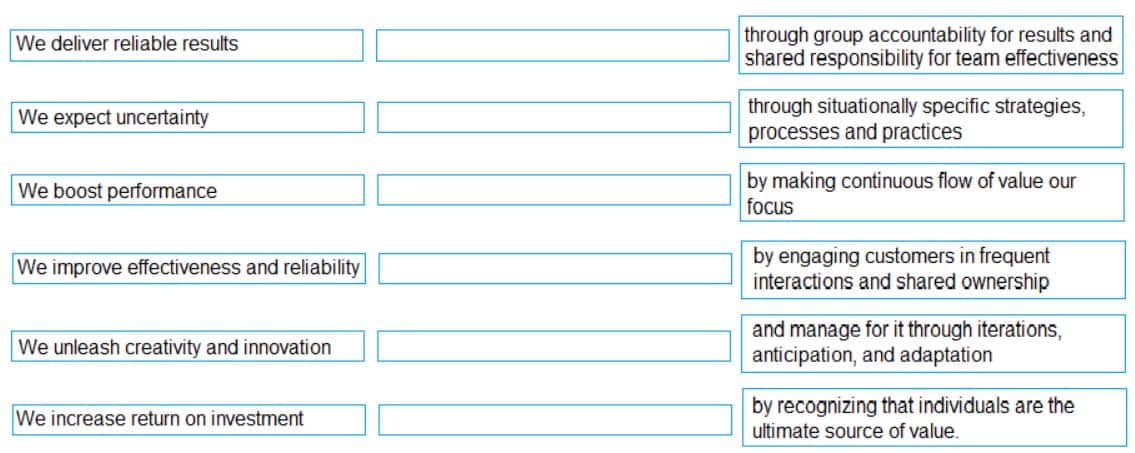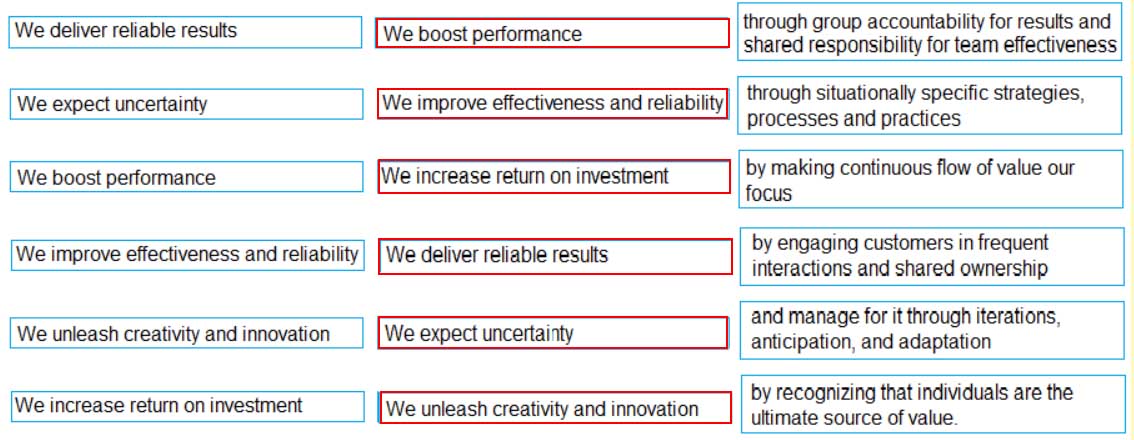PMI-ACP : PMI Agile Certified Practitioner : Part 15
-
On Agile teams, conflict is to be avoided at all cost.
- True
- False
-
Suppose you are a Scrum Master on a new Agile team. Which of the following strategies is best way to resolve conflict on the team?
- Collaborate
- Negotiate
- Smooth over
- Ignore
- Use your authority
-
DRAG DROP
Match the response options to each level of conflict.

PMI-ACP PMI Agile Certified Practitioner Part 15 Q03 012 Question 
PMI-ACP PMI Agile Certified Practitioner Part 15 Q03 012 Answer Explanation:
Level 1: Problem to Solve – Collaboration or consensus
Level 2: Disagreement – Support & safety
Level 3: Contest – Accommodate, negotiate, get factual
Level 4: Crusade – Establish safe structures again
Level 5: World War – Do whatever is necessary -
Which of the following is NOT one of the 5 common conflict types?
- Compensation anxiety
- Lack of role clarity
- Difference in prioritizing tasks
- Working in silos
- Waiting on completion of task dependencies
- Lack of communication
-
When we use the term “container” in Scrum what are we referring to?
- A Sprint or Iteration
- Source code repository
- Development team room
- A vertical slice of functionality
-
Prioritize from high to low the sequence of User Story development.
- Lower-value, low-risk
- High-value, low-risk
- High-value, high-risk stories
- Low-value, high-risk
Explanation:
C, B, A, D (in that order) -
The number of days needed between feature specification and production delivery is called:
- Cycle time
- Real time
- Ideal time
- Calendar time
-
DRAG DROP
The PM Declaration of Interdependence is a set of six management principle initially intended for project managers of Agile software development projects. Match the items below to identify the principles.

PMI-ACP PMI Agile Certified Practitioner Part 15 Q08 013 Question 
PMI-ACP PMI Agile Certified Practitioner Part 15 Q08 013 Answer Explanation:
We deliver reliable results – By engaging customers in frequent interactions & shared ownership
We expect uncertainty – And manage for it through iterations, anticipation & adaptation
We boost performance – Through group accountability for results & shared responsibility for team effectiveness
We improve effectiveness and reliability – Through situationally specific strategies, processes & practices
We unleash creativity and innovation – By recognizing that individuals are the ultimate source of value
We increase our return on investment – By making continuous flow of value our focus -
All of the following are attributes of the definition of “Done”, EXCEPT:
- It is a static artifact
- It is an audible checklist
- It is a primary reporting mechanism for team members on User Story progress
- It is crucial to a high-performing team
-
The way that we calculate the number of years it takes to break even from undertaking a project which also takes into account the time value of money is the:
- Pay-back period
- Discounted pay-back period
- NPV
- Cumulative cash flow
-
DRY is an acronym for which Agile development principle?
- Development Requires You
- Don’t Repeat Yourself
- Deploy Repeatedly
- Develop, Refactor, Yagni
-
When is the best time to perform Earned Value Measurement (EVM) in Agile projects?
- After the iteration
- After a release
- During an iteration
- Never – we don’t perform EVM in Agile
-
Emotional intelligence includes all of the following except:
- Self-awareness
- Motivation
- Commitment
- Influence
- Intuitiveness
- Conscientiousness
-
In a burndown chart, if the remaining work line is above the expected work line, what does this signify?
- The project is ahead of schedule
- The project is behind schedule
- The resources are performing above expectation
- The project is being well managed
-
Empirical process control constitutes a continuous cycle of inspecting the process for correct operation and results and adapting the process as needed. What characteristics does this apply to in Scrum?
- Self-organization, Collaboration and Time-boxing
- Quality, Cost and Scope
- Scrums, Sprint and Releases
- Transparency, Inspection and Adaption
-
Bugs reported by the customer that have slipped by all software quality processes are represented in this metric.
- Technical debt
- Escaped defects
- Risk burndown
- Code quality
-
Testing that often occurs between “Done” and “Done, Done” is:
- Exploratory testing
- Acceptance testing
- Unit testing
- Test driven development
-
Which of the following is NOT one of the 12 core practices of XP:
- The Planning Game
- Planning Poker
- Small Releases
- System Metaphor
-
Which of the following is NOT one of the 12 core practices of XP:
- Simple Design
- Continuous Testing
- Vertical Slicing
- Refactoring
-
Which of the following is NOT one of the 12 core practices of XP:
- Pair Programming
- Collective Code Ownership
- 40-Hour Work Week
- Minimize Waste
Subscribe
0 Comments
Newest